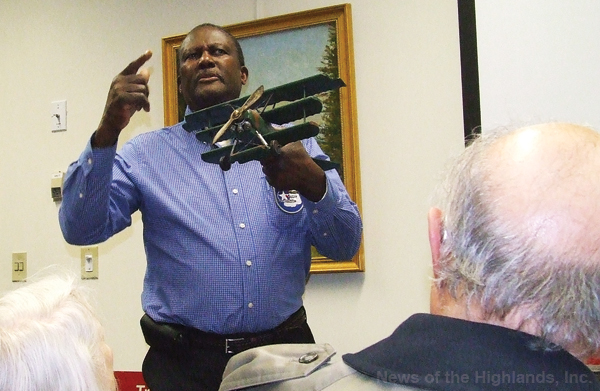
Glendon Fraser remembers the first fund-raising events for the local chapter of the Tuskegee Airmen. Some of the original airmen would attend. They were good dancers, despite their age. And they were wonderful story-tellers, who would sometimes embellish their tales.
The airmen don’t show up to the dinner-dances anymore. Like other World War II veterans, they’re either deceased or too old to travel. So it’s up to the local chapters to keep their memory alive.
That’s what Mr. Fraser and his colleagues were doing for a large crowd at the library on Jan. 25. The parking lot was full so that latecomers had to leave their cars on the road leading up to Munger Cottage. Library staff members added a row of chairs to the Community Room, but there were still people standing.
The crowd was knowledgeable. Most of the audience knew that the airmen were members of the 332nd Expeditionary Operations Group, which was formed during World War II. At the time, America’s Armed Forces were segregated.
The airmen didn’t see combat right away. Their entry into the war was delayed by a 1925 study, which claimed there was a difference in the capability of the races. The airmen had to prove that the study was wrong — which they accomplished with an unparalleled record as bomber escorts.
Some sources say the airmen never lost a plane they were escorting. Mr. Fraser disagreed. But a member of the audience maintained that if the airmen lost a bomber, it was due to engine failure or fatigue.
Why were the airmen so successful? The Wednesday night speakers offered a few reasons. One: Their commander, Benjamin O. Davis, refused to let them break formation to chase after enemy planes. Two: Their delayed entry into combat gave them more time for training.
Stephan Wilkinson, the corresponding secretary of the local chapter, offered another explanation. The airmen were highly proficient. After the war was over, they won a fighter pilot competition in 1949, which made them the “Top Guns” in the Air Force. The trophy for the competition mysteriously disappeared, and was found in a museum basement almost a half century later.
While Mr. Fraser had met several of the World War II airmen. Harvey Horn, a member of the Wednesday night audience, got to know them from a different perspective. As a World War II bomber plane navigator, he flew along side them on several missions.
Mr. Horn received a commemorative coin from Mr. Fraser, who cited two other functions of the Maj. Gen. Irene Trowell-Harris Chapter at Stewart Air Force Base. The chapter provides tuition assistance awards for graduating high school students and offers flying lessons to teenagers of all races. “We were going to limit it to black pilots,” Mr. Fraser said, “but that would have been against everything the Tuskegee Airmen fought for.”


